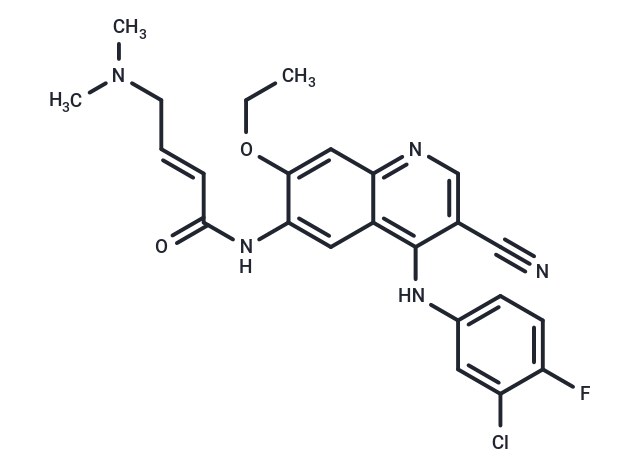Shopping Cart
- Remove All
 Your shopping cart is currently empty
Your shopping cart is currently empty

Pelitinib (EKB-569) (EKB-569) is an effective irreversible EGFR inhibitor (IC50: 38.5 nM).

| Pack Size | Price | Availability | Quantity |
|---|---|---|---|
| 5 mg | $43 | In Stock | |
| 10 mg | $61 | In Stock | |
| 25 mg | $107 | In Stock | |
| 50 mg | $133 | In Stock | |
| 100 mg | $198 | In Stock | |
| 500 mg | $490 | In Stock | |
| 1 mL x 10 mM (in DMSO) | $48 | In Stock |
| Description | Pelitinib (EKB-569) (EKB-569) is an effective irreversible EGFR inhibitor (IC50: 38.5 nM). |
| Targets&IC50 | EGFR:38.5 nM |
| In vitro | In the A431 xenograft model targeting EGFR, Pelitinib (10 mg/kg, p.o.) effectively inhibits EGFR phosphorylation, achieving a 90% inhibition within 1 hour and maintaining over 50% inhibition after 24 hours. In the mouse airway epithelial cell remodeling model, which can be induced by viral infection and is characterized by a delayed yet permanent transition to goblet cell metaplasia, Pelitinib (20 mg/kg/day) completely blocks the increase of ciliated cells and the decrease of Clara cells, thereby correcting epithelial cell remodeling from three different aspects and significantly inhibiting the occurrence of goblet cells. Additionally, Pelitinib (20 mg/kg/day) inhibits 87% of tumor occurrence in APCMin/+ mice, which is comparable to the effect of a double dose of EKI-785 (40 mg/kg/day), consistent with its higher in vivo activity. Pelitinib exhibits selective inhibitory effects on EGFR signaling in airway epithelial cells in vivo. |
| In vivo | Pelitinib (75-500 nM) specifically inhibits the activation of AKT and ERK1/2 without affecting the NF-κB pathway. In normal human keratinocytes, Pelitinib effectively inhibits TGF-α-mediated EGFR activation (IC50: 56 nM) and the activation of STAT3 and ERK1/2 (IC50: 60 nM and 62 nM, respectively). It also suppresses EGF-induced EGFR phosphorylation (IC50: 20-80 nM) and STAT3 phosphorylation (IC50: 30-70 nM) in both A431 cells and normal human keratinocytes. Moreover, Pelitinib significantly inhibits the proliferation of normal human keratinocytes (IC50: 61 nM), A431 (IC50: 125 nM), and MDA-468 (IC50: 260 nM) tumor cells, but shows lower activity against MCF-7 cells (IC50: 3.6 μM). |
| Kinase Assay | Autophosphorylation of EGFR in cells: For experiments using cells in culture, A431 cells are treated with various concentrations of Pelitinib for 2.75 hours before co-incubation with 100 ng/mL EGF for 0.25 hour. Cells are washed twice with cold phosphate-buffered saline (PBS) before adding to lysis buffer (10 mM Tris, pH 7.5, 5 mM ethylenediamine tetra-acetic acid (EDTA), 150 mM NaCl, 1% Triton X-100, 1% Sodium deoxycholate, 0.1 % SDS, 1 mM PMSF, 10 mg/mL pepstatin A, 10 mg/mL leupeptin, 20 KIU/mL aprotinin, 2 mM sodium orthovanadate, and 100 mM sodium fluoride) for 20 minutes on ice, before immunoprecipitation and SDS-PAGE-immunoblotting. For immunoprecipitation, cultured cells are placed in cold lysis buffer and immediately homogenized on ice with a polytron with several pulses. The homogenate is first centrifuged at 2500 rpm (20 minutes, 4 °C) and then again at 14,000 rpm in a microcentrifuge (10 minutes, 4 °C). Supernatants (1000 μg protein) are incubated for 2 hours at 4 °C with 15 mL of EGFR polyclonal antibody. After 2 hours, 50 μL of protein G plus/protein A agarose beads is added and incubated with constant rotation for 2 hours at 4 °C. After washing with lysis buffer, beads are boiled for 2 minutes in Laemmli sample buffer. Proteins are then resolved by SDS-PAGE, transferred to immobilon membrane and probed overnight with an anti-phosphotyrosine antibody conjugated with horseradish peroxidase (HRP). Membranes are developed using the ECL reagent. Total EGFR protein is determined by stripping membranes and re-probing with receptor-specific antibodies. Quantitation of bands is done by densitometry, using ImageQuant software with a Molecular Dynamics laser transmittance scanner. |
| Cell Research | Cells are seeded in 96-well dishes, and after 2 hours, Pelitinib is added and incubated for 5 days. After incubation, the medium is removed from each well and fresh medium (150 μL) + 1 mg/mL MTT solution (50 μL) is added. After incubation for 2 hours at 37 °C, the medium is replaced with 150 μL DMSO, and absorbance at 540 nm in each well is determined. The IC50 is calculated by linear regression of the data. (Only for Reference) |
| Alias | WAY-EKB 569, EKB-569 |
| Molecular Weight | 467.92 |
| Formula | C24H23ClFN5O2 |
| Cas No. | 257933-82-7 |
| Smiles | CCOc1cc2ncc(C#N)c(Nc3ccc(F)c(Cl)c3)c2cc1NC(=O)\C=C\CN(C)C |
| Relative Density. | 1.34 g/cm3 |
| Storage | Powder: -20°C for 3 years | In solvent: -80°C for 1 year | Shipping with blue ice. | |||||||||||||||||||||||||
| Solubility Information | H2O: < 1 mg/mL (insoluble or slightly soluble) Ethanol: < 1 mg/mL (insoluble or slightly soluble) DMSO: 9.43 mg/mL (20.15 mM), Sonication is recommended. | |||||||||||||||||||||||||
Solution Preparation Table | ||||||||||||||||||||||||||
DMSO
| ||||||||||||||||||||||||||

Copyright © 2015-2025 TargetMol Chemicals Inc. All Rights Reserved.